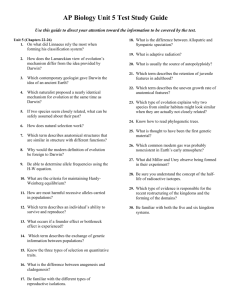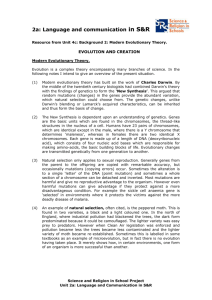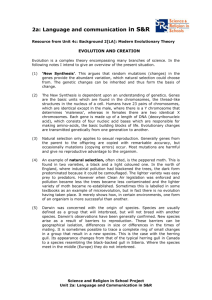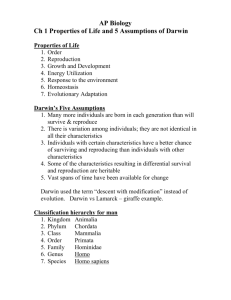The Theory of Evolution
advertisement
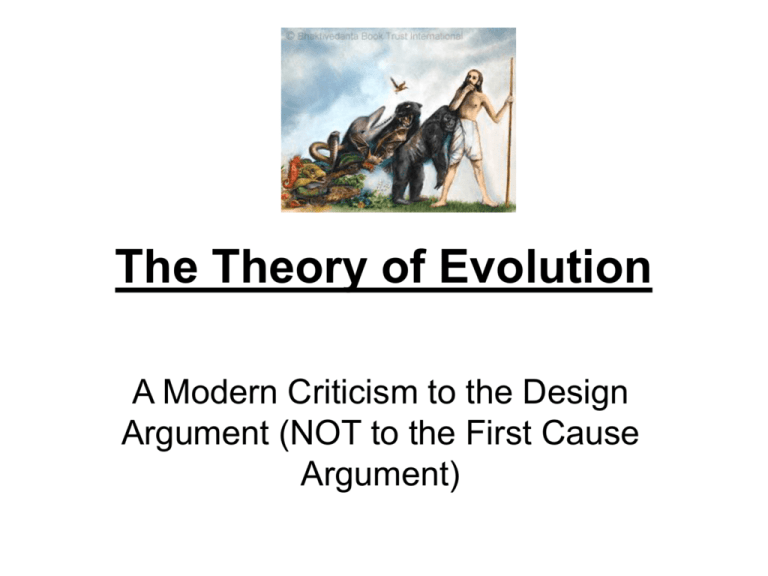
The Theory of Evolution A Modern Criticism to the Design Argument (NOT to the First Cause Argument) Evolutionary Theory • • • • • The word ‘evolution’ means ‘gradual development’ Evolutionary ideas have been present (although not widely known) throughout history. It was not until the observations of Charles Darwin (19th C) that a scientific theory of evolution began to emerge. Darwin’s original theory was written in his Origin of Species in 1859. Therefore, there was no theory of evolution at Hume / Paley’s time. The Science of Evolution - Darwinism 1. Charles Darwin studied biology and geology, and was also interested in the works of William Paley! 2. On a 5 year voyage that took him to the Galapagos Islands he began to wonder why God would have bothered making different species for each different island. 3. He began to think that there was no ‘fixity of species’, but that they might instead be developing from a finite number of ‘original’ species. 4. On return home, Darwin began working on his new theory and was influenced by several writers (see p.46) 5. He liked the idea in Malthus of every being ‘fighting for survival’ where only the strongest survive. This led to the idea we now know of as natural selection (Darwin likened this to artificial selection in animal breeders). 6. Darwin believed if the natural variation in generations (longer legs, etc) were the traits to ‘win’ and develop, then over millions of years there could be a completely different group of animals / species from the original. 7. He later, in Descent of Man applied this controversial theory to humans. Summary of Darwinism 1. Life originates from a primeval ‘soup’ 3,5004,000 million years ago. 2. Initial species developed with the fittest surviving. 3. Competition amongst species lead to the fittest offspring surviving (there are always more babies than the environment can support – they compete for resources to survive and best adapted wins!) 4. No single act of creation needed for each species. 5. Humans are different by ‘degree’ not kind. Neo-Darwinism • This is the type of evolutionary theory we have today. It is based on the original ideas of Darwin, but revised with more scientific evidence. • Darwin’s original theory did not account for emergent species, just adaptation to environments. • Gregor Mendel came up with a mathematical formula that became the basis for evolutionary biology. • Then, Francis Crick and James Watson worked out the structure of DNA, and how genes are passed on through generations – half DNA from each parent to make NEW COMBINATIONS. • This natural variety, and random mutations (when something ‘goes wrong’ in someone’s genes and leads to disability or an advantage), make up the changes we see in species over long periods of time. The best changes survive. • Life itself started with the first molecule of DNA, although scientists do not know how atoms managed to form living cells, and developed through mutations. We now ‘know’ that: 1. 2. 3. 4. 5. Life probably started 4000 million years ago, although 2000 million years of this would have been mostly bacteria. 1000 million years ago, simple multi-celled (visible) life would have appeared, with plants and animals soon to follow. Variation in life is caused by gene mutations. These survive if they allow best adaptation to environment. This process of change happens over many generations. Evolution by natural selection therefore rules out the need for God.




